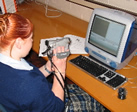Primary 8
Year 4 pupils at Milton County Junior School have been discovering aspects of Jewish religious life. Milton County Junior School, in Weston-super-Mare, north Somerset, is a junior school for pupils aged 7 to 11.
this was part of a unit of work for Year 4 pupils on Jewish belief and practice. Children had already discussed family life and seen the BBC’s Pathways of Belief programmes on Judaism, God and the family. They were learning about Shabbat, and focused on a key question: 'How do Jews show commitment to their faith?'
Pupils used PCs with a CD-ROM drive and an internet connection. They were supported by the school's RE and IT co-ordinators. They used the Exploring World Religions (Granada) CD-ROM and three previously checked websites (listed below).
First, using the CD-ROM, pupils learned that Jewish customs are based on writings in the Torah, Mishnah and Talmud. They also discovered the special laws about food, including forbidden foods (terefah). Selected pictures and text were printed to include in their project files.
Next, they used the internet to discover the precise times for Shabbat in London and Cardiff, and the location of the nearest synagogues to their school (which they discovered are in Bristol). They noticed that the times over two weeks were about an hour apart, and discussed the reliability of that information. They eventually realised that the change to British Summer Time accounted for the difference in Shabbat times over the two weeks.
The children learned more about Jewish food laws for instance, how milk and meat products are kept separate when they took an online tour of the Jewish synagogue at Colchester. Finally, they sent three questions by email to a rabbi, via the jewish.co.uk website.
A small group of students was withdrawn from the class. A computer with CD-ROM and internet access was booked. This was a pilot for the whole class to see how things might work once the computer suite was operational. The group worked for 90 minutes, and the children’s previous learning was valuable in making the best use of the material.
Going further
The children gave verbal feedback to the class about their discoveries, and volunteered to write a report for class display which would also include the rabbi’s responses to their questions.
The activities will be extended to the whole class and will become part of the regular programme of study. The programme may also be used as a model for investigation in other units of the agreed syllabus.
The Key Stage 2 unit on Judaism indicates that pupils should learn about some of the practices associated with belonging to a Jewish group or community. For ICT (1c) pupils are required to interpret information, check whether it is relevant and reasonable, and think about what could happen if there were any errors or omissions.
How ICT enhanced teaching and learning
The CD-ROM helped children to discover quickly some key features of Jewish life and practice. The Internet sites provided up-to-date information, although the children did question the reliability of the information on these sites.
The children were particularly interested in being able to send email questions to members of the Jewish community and receive answers a few days later. In north Somerset, it is not always easy to make personal contact with members of the various religious communities.
Related Resources on the Becta website
Using web-based resources in primary religious education - go
Other Links
The British Jewish Network Jewish.co.uk has the latest news and topics of Jewish cultural interest, including the facility to email a rabbi.
Topmarks.co.uk has links to resources on a variety of curriculum topics, including RE. There are links to sites on Judaism.
Jewish synagogue: take on online tour of the Jewish synagogue in Colchester.

